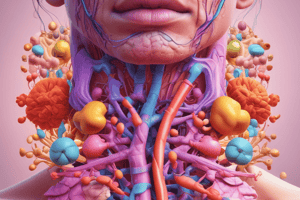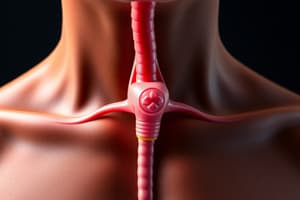Podcast
Questions and Answers
What are potential causes of abnormalities in endocrine function?
What are potential causes of abnormalities in endocrine function?
- Hypersecretion or hyposecretion of hormones (correct)
- Alterations in feedback mechanisms only
- Increased receptor density
- Defects in second-messenger generation (correct)
Which of the following is a characteristic of SIADH secretion?
Which of the following is a characteristic of SIADH secretion?
- Increased urine osmolality
- Low ADH secretion
- High ADH levels (correct)
- Hypernatremia
How can DI be categorized?
How can DI be categorized?
- Acute or chronic
- Primarily alimentary
- Neurogenic or nephrogenic (correct)
- Chemical or physical
What is a potential consequence of hypopituitarism?
What is a potential consequence of hypopituitarism?
What type of tumor typically causes hyperpituitarism?
What type of tumor typically causes hyperpituitarism?
How does ectopic secretion affect hormone levels?
How does ectopic secretion affect hormone levels?
What neurological effects may arise from pituitary adenomas?
What neurological effects may arise from pituitary adenomas?
Which mechanism does NOT contribute to alterations in receptor function?
Which mechanism does NOT contribute to alterations in receptor function?
What is the most common cause of primary hyperparathyroidism?
What is the most common cause of primary hyperparathyroidism?
Which condition is characterized by excessive secretion of PTH after prolonged hypocalcemia?
Which condition is characterized by excessive secretion of PTH after prolonged hypocalcemia?
What impact does hypoparathyroidism have on serum calcium levels?
What impact does hypoparathyroidism have on serum calcium levels?
In type 1 diabetes mellitus, which type is associated with autoimmune destruction of pancreatic beta cells?
In type 1 diabetes mellitus, which type is associated with autoimmune destruction of pancreatic beta cells?
What is the most compelling environmental risk factor for type 2 diabetes mellitus?
What is the most compelling environmental risk factor for type 2 diabetes mellitus?
Which test is NOT used to diagnose diabetes mellitus?
Which test is NOT used to diagnose diabetes mellitus?
What is a common consequence of insulin resistance in type 2 diabetes mellitus?
What is a common consequence of insulin resistance in type 2 diabetes mellitus?
What condition is a result of resistance to PTH?
What condition is a result of resistance to PTH?
What is the most common cause of acromegaly in adults?
What is the most common cause of acromegaly in adults?
Which condition is characterized by elevated levels of thyroid hormones and exaggerates physiological responses in tissues?
Which condition is characterized by elevated levels of thyroid hormones and exaggerates physiological responses in tissues?
What is the cutaneous manifestation of Graves disease?
What is the cutaneous manifestation of Graves disease?
Which of the following is NOT a common manifestation of hyperthyroidism?
Which of the following is NOT a common manifestation of hyperthyroidism?
What results from prolonged hypersecretion of growth hormone (GH) in adults?
What results from prolonged hypersecretion of growth hormone (GH) in adults?
Which of the following statements about the ocular manifestations of Graves disease is true?
Which of the following statements about the ocular manifestations of Graves disease is true?
Which of the following describes the impact of GH deficiency in children?
Which of the following describes the impact of GH deficiency in children?
What causes toxic multinodular goiter?
What causes toxic multinodular goiter?
What is a consequence of amylin deficiency in type 2 diabetes?
What is a consequence of amylin deficiency in type 2 diabetes?
Which mechanism is NOT associated with the development of insulin resistance?
Which mechanism is NOT associated with the development of insulin resistance?
What condition is characterized by a combination of hypoglycemia and rebound hyperglycemia?
What condition is characterized by a combination of hypoglycemia and rebound hyperglycemia?
Which of the following is a chronic complication of diabetes mellitus?
Which of the following is a chronic complication of diabetes mellitus?
Which of the following accurately describes HHNKS?
Which of the following accurately describes HHNKS?
What primarily causes the early morning rise in glucose levels known as the dawn phenomenon?
What primarily causes the early morning rise in glucose levels known as the dawn phenomenon?
The release of inflammatory cytokines contributes to what aspect of metabolic syndrome?
The release of inflammatory cytokines contributes to what aspect of metabolic syndrome?
Which condition is characterized by glucose intolerance occurring during pregnancy?
Which condition is characterized by glucose intolerance occurring during pregnancy?
Which of the following mechanisms contributes to diabetic retinopathy?
Which of the following mechanisms contributes to diabetic retinopathy?
What is a consequence of diabetic nephropathy?
What is a consequence of diabetic nephropathy?
Which of the following is NOT a contributing factor to microvascular complications in diabetes?
Which of the following is NOT a contributing factor to microvascular complications in diabetes?
Diabetic neuropathies can arise from which of the following?
Diabetic neuropathies can arise from which of the following?
What condition is associated with accelerated atherosclerosis in diabetes?
What condition is associated with accelerated atherosclerosis in diabetes?
Which of the following is a potential risk for individuals with diabetes?
Which of the following is a potential risk for individuals with diabetes?
What is the primary mechanism behind hypercortisolism?
What is the primary mechanism behind hypercortisolism?
Peripheral artery disease in diabetes primarily results from what factors?
Peripheral artery disease in diabetes primarily results from what factors?
What causes Cushing syndrome?
What causes Cushing syndrome?
Which condition would lead to increased levels of ACTH and adrenal hyperplasia?
Which condition would lead to increased levels of ACTH and adrenal hyperplasia?
What is primarily responsible for weight gain and glucose intolerance in individuals with Cushing disease?
What is primarily responsible for weight gain and glucose intolerance in individuals with Cushing disease?
Which of the following is a characteristic of primary hyperaldosteronism?
Which of the following is a characteristic of primary hyperaldosteronism?
Addison disease can lead to which of the following hormonal imbalances?
Addison disease can lead to which of the following hormonal imbalances?
Secondary hyperaldosterone secretion can be triggered by which of the following conditions?
Secondary hyperaldosterone secretion can be triggered by which of the following conditions?
Which factor is most commonly associated with Cushing disease?
Which factor is most commonly associated with Cushing disease?
What is the primary consequence of adrenal cortex hypofunction?
What is the primary consequence of adrenal cortex hypofunction?
Flashcards
Hypopituitarism
Hypopituitarism
Impaired function of the pituitary gland, leading to insufficient hormone production.
Hyperpituitarism
Hyperpituitarism
Excess hormone production by the pituitary gland, often caused by tumors.
Syndrome of Inappropriate ADH Secretion (SIADH)
Syndrome of Inappropriate ADH Secretion (SIADH)
A condition characterized by abnormally high levels of antidiuretic hormone (ADH).
Diabetes Insipidus (DI)
Diabetes Insipidus (DI)
Signup and view all the flashcards
Ectopic Hormone Secretion
Ectopic Hormone Secretion
Signup and view all the flashcards
Downregulation
Downregulation
Signup and view all the flashcards
Hormone Resistance
Hormone Resistance
Signup and view all the flashcards
Hyposecretion
Hyposecretion
Signup and view all the flashcards
Primary Hyperparathyroidism
Primary Hyperparathyroidism
Signup and view all the flashcards
Secondary Hyperparathyroidism
Secondary Hyperparathyroidism
Signup and view all the flashcards
Tertiary Hyperparathyroidism
Tertiary Hyperparathyroidism
Signup and view all the flashcards
Pseudohypoparathyroidism
Pseudohypoparathyroidism
Signup and view all the flashcards
Hypoparathyroidism
Hypoparathyroidism
Signup and view all the flashcards
Diabetes Mellitus
Diabetes Mellitus
Signup and view all the flashcards
Type 1 Diabetes Mellitus
Type 1 Diabetes Mellitus
Signup and view all the flashcards
Type 2 Diabetes Mellitus
Type 2 Diabetes Mellitus
Signup and view all the flashcards
Acromegaly
Acromegaly
Signup and view all the flashcards
Giantism
Giantism
Signup and view all the flashcards
Thyrotoxicosis
Thyrotoxicosis
Signup and view all the flashcards
Graves' disease
Graves' disease
Signup and view all the flashcards
Pretibial myxedema
Pretibial myxedema
Signup and view all the flashcards
Exophthalmos
Exophthalmos
Signup and view all the flashcards
Toxic multinodular goiter
Toxic multinodular goiter
Signup and view all the flashcards
Solitary toxic adenoma
Solitary toxic adenoma
Signup and view all the flashcards
Oxidative stress in diabetes
Oxidative stress in diabetes
Signup and view all the flashcards
Polyol pathway activation
Polyol pathway activation
Signup and view all the flashcards
Protein kinase C activation
Protein kinase C activation
Signup and view all the flashcards
Advanced glycation end products (AGEs)
Advanced glycation end products (AGEs)
Signup and view all the flashcards
Hexosamine pathway activation
Hexosamine pathway activation
Signup and view all the flashcards
Diabetic neuropathy
Diabetic neuropathy
Signup and view all the flashcards
Diabetic retinopathy
Diabetic retinopathy
Signup and view all the flashcards
Diabetic nephropathy
Diabetic nephropathy
Signup and view all the flashcards
Insulin Resistance in Type 2 Diabetes
Insulin Resistance in Type 2 Diabetes
Signup and view all the flashcards
Type 1 Diabetes
Type 1 Diabetes
Signup and view all the flashcards
Type 2 Diabetes
Type 2 Diabetes
Signup and view all the flashcards
Hypoglycemia
Hypoglycemia
Signup and view all the flashcards
Diabetic Ketoacidosis (DKA)
Diabetic Ketoacidosis (DKA)
Signup and view all the flashcards
Hyperosmolar Hyperglycemic State (HHNS)
Hyperosmolar Hyperglycemic State (HHNS)
Signup and view all the flashcards
Chronic Complications of Diabetes
Chronic Complications of Diabetes
Signup and view all the flashcards
Somogyi Effect
Somogyi Effect
Signup and view all the flashcards
Cushing syndrome
Cushing syndrome
Signup and view all the flashcards
Cushing disease
Cushing disease
Signup and view all the flashcards
Congenital adrenal hyperplasia
Congenital adrenal hyperplasia
Signup and view all the flashcards
Primary hyperaldosteronism
Primary hyperaldosteronism
Signup and view all the flashcards
Secondary hyperaldosteronism
Secondary hyperaldosteronism
Signup and view all the flashcards
Hypocortisolism
Hypocortisolism
Signup and view all the flashcards
Addison disease
Addison disease
Signup and view all the flashcards
Adrenal tumors
Adrenal tumors
Signup and view all the flashcards
Study Notes
Mechanisms of Hormonal Alterations
- Abnormalities in endocrine function can be caused by hypersecretion, hyposecretion, or transport molecule alterations.
- Endocrine abnormalities can involve receptor alterations: decreased receptor numbers, receptor insensitivity, receptor antibodies, or second-messenger/post-receptor defects.
- Excessive hormone levels can arise from hormone release outside the endocrine system (ectopic foci), functioning independently of feedback mechanisms.
Alterations of the Hypothalamic-Pituitary System
- Hypothalamic hormone release dysfunction may be due to disruptions in the hypothalamic-pituitary connection (e.g., pituitary stalk interruption).
- Posterior pituitary disorders include Syndrome of Inappropriate Antidiuretic Hormone (SIADH) and Diabetes Insipidus (DI).
- SIADH involves excessive ADH, leading to hyponatremia and hypoosmolality (due to impaired water clearance by the kidneys). This is often associated with cancer-related ectopic ADH secretion.
- DI can be neurogenic (inadequate ADH) or nephrogenic (insufficient ADH response). Symptoms include polyuria and polydipsia (excessive urination and thirst). Dipsogenic polyuria is due to excessive fluid intake.
- Hypopituitarism is anterior pituitary dysfunction, causing hormone deficiencies (mild to severe symptoms). Causes include pituitary infarction, space-occupying lesions, surgery, or infections.
- Hyperpituitarism is caused by pituitary adenomas (benign, slow-growing tumors). Expansion of these tumors can cause problems with other structures (optic chiasm leading to vision issues, hypothalamic/cranial nerve dysfunction), and hyposecretion from nearby cells.
- Excessive growth hormone (GH) secretion causes acromegaly (adults) or gigantism (children). The most common cause is a pituitary adenoma.
- GH excess leads to tissue proliferation, affecting the renal, thyroid, cardiovascular, and reproductive systems. Insulin resistance and structural changes in bone are also possible consequences.
- GH deficiency in children leads to stunted growth and hypoglycemia. In adults, it can cause fatigue, osteoporosis, and increased mortality.
- Prolactinomas, renal failure, or medications can increase prolactin levels.
Alterations of Thyroid Function
- Thyrotoxicosis is characterized by elevated thyroid hormone (TH) levels and an exaggerated physiological response.
- Hyperthyroidism (elevated TH levels) can manifest as various endocrine, reproductive, gastrointestinal, integumentary, and ocular symptoms. It's related to increased sympathetic nervous system activity.
- Graves disease is the most common cause of hyperthyroidism. It involves thyroid-stimulating immunoglobulins that stimulate TSH receptors, leading to hyperactivity and enlargement of the thyroid gland.
- Graves disease symptoms include hyperthyroidism, goiter (enlarged thyroid), and eye/skin issues (pretibial myxedema, exophthalmos).
- Toxic multinodular goiter and toxic adenoma are other causes of hyperthyroidism. Hyperfunctioning nodules autonomously produce TH.
- A thyroid storm (thyrotoxic crisis) is a life-threatening hyperthyroidism complication often triggered by stress.
- Hypothyroidism involves deficient TH production by the thyroid. This can be primary (issues with the thyroid itself), secondary (issues with the hypothalamus/pituitary), or subclinical (not clinically apparent).
- Causes of primary hypothyroidism include iodine deficiency, autoimmune thyroiditis, subacute/painless thyroiditis, silent/lymphocytic thyroiditis, iatrogenic hypothyroidism, and postpartum thyroiditis.
- Autoimmune thyroiditis (Hashimoto disease) involves lymphocyte infiltration, antibody action on natural killer cells, apoptosis, and gradual thyroid function loss.
- Subacute thyroiditis is a self-limiting inflammation of the thyroid. Initial hyperthyroidism can follow by a transient hypothyroid state.
- Secondary hypothyroidism arises from hypothalamic/pituitary dysfunction, resulting in inadequate TRH and/or TSH production.
- Thyroid cancer is relatively rare, with exposure to ionizing radiation being a major risk factor.
- Hypothyroidism symptoms involve decreased metabolic rate and heat production. Myxedema is a characteristic sign, with connective tissue alterations and water retention. Myxedema coma is a dangerous complication needing emergency care.
Studying That Suits You
Use AI to generate personalized quizzes and flashcards to suit your learning preferences.




